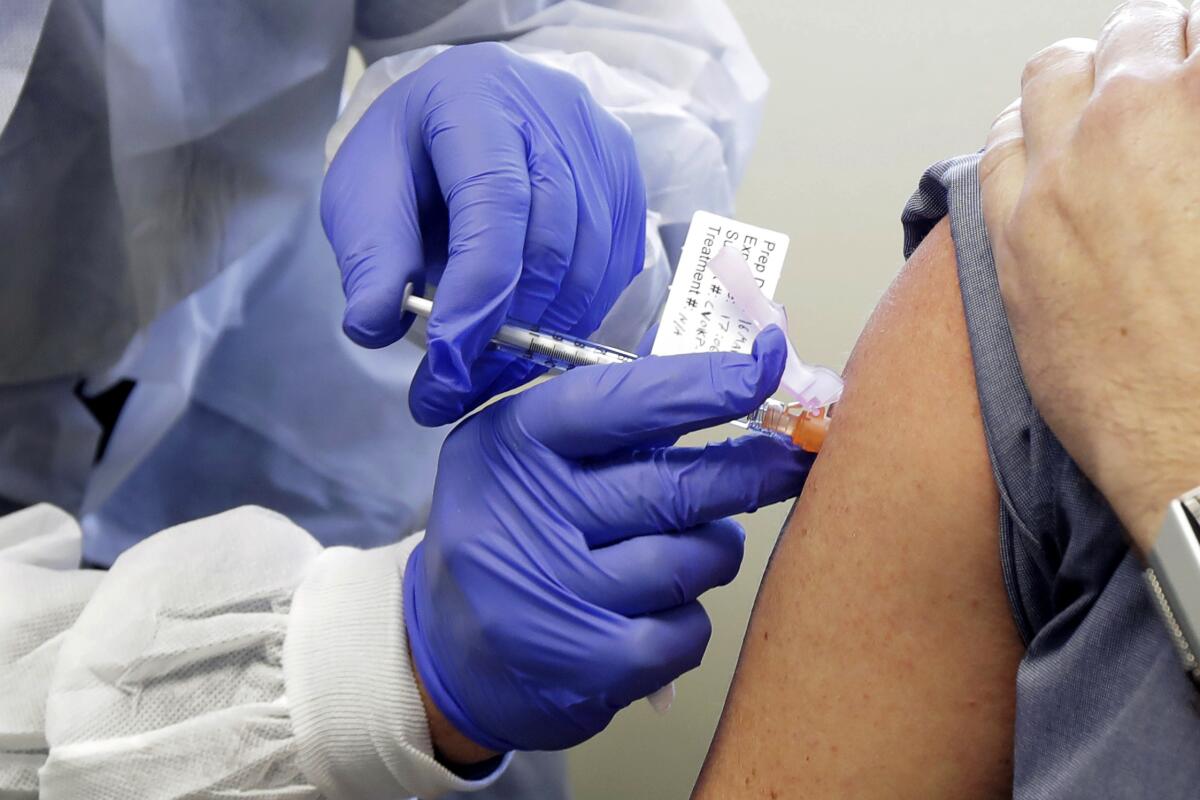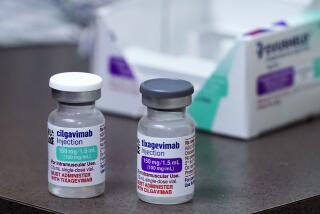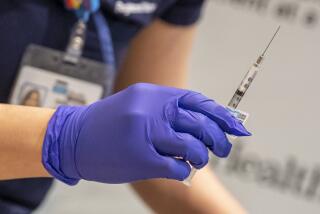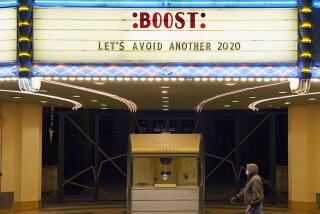A plasma shot could prevent coronavirus. But feds and makers won’t act, scientists say

- Share via
It might be the next best thing to a coronavirus vaccine.
Scientists have devised a way to use the antibody-rich blood plasma of COVID-19 survivors for an upper-arm injection that they say could inoculate people against the virus for months.
Using technology that’s been proven effective in preventing other diseases such as hepatitis A, the injections would be administered to high-risk healthcare workers, nursing home patients, or even at public drive-through sites — potentially protecting millions of lives, the doctors and other experts say.
The two scientists who spearheaded the proposal — an 83-year-old shingles researcher and his counterpart, an HIV gene therapy expert — have garnered widespread support from leading blood and immunology specialists, including those at the center of the nation’s COVID-19 plasma research.
But the idea exists only on paper. Federal officials have twice rejected requests to discuss the proposal, and pharmaceutical companies — even acknowledging the likely efficacy of the plan — have declined to design or manufacture the shots, according to a Times investigation. The lack of interest in launching development of immunity shots comes amid heightened scrutiny of the federal government’s sluggish pandemic response.
There is little disagreement that the idea holds promise; the dispute is over the timing. Federal health officials and industry groups say the development of plasma-based therapies should focus on treating people who are already sick, not on preventing infections in those who are still healthy.
Dr. Anthony Fauci, director of the National Institute of Allergy and Infectious Diseases at the National Institutes of Health, said an upper-arm injection that would function like a vaccine “is a very attractive concept.”
However, he said, scientists should first demonstrate that the coronavirus antibodies that are currently delivered to patients intravenously in hospital wards across the country actually work. “Once you show the efficacy, then the obvious next step is to convert it into an intramuscular” shot.
But scientists who question the delay argue that the immunity shots are easy to scale up and should enter clinical trials immediately. They say that until there’s a vaccine, the shots offer the only plausible method for preventing potentially millions of infections at a critical moment in the pandemic.
“Beyond being a lost opportunity, this is a real head-scratcher,” said Dr. Michael Joyner, a Mayo Clinic researcher who leads a program sponsored by the Food and Drug Administration to capitalize on coronavirus antibodies from COVID-19 survivors. “It seems obvious.”
::
The use of so-called convalescent plasma has already become widespread. More than 28,000 patients have already received the IV treatment, and preliminary data suggest that the method is safe. Researchers are also looking at whether the IV drip products would prevent new infections from taking root.
The antibodies in plasma can be concentrated and delivered to patients through a type of drug called immune globulin, or IG, which can be given through either an IV drip or a shot. IG shots have for decades been used to prevent an array of diseases; the IG shot that prevents hepatitis A was first licensed in 1944. They are available to treat patients who have recently been exposed to hepatitis B, tetanus, varicella and rabies.
Yet for the coronavirus, manufacturers are only developing an intravenous solution of IG.
Joyner told The Times that 600 COVID-19 survivors donating their plasma each day could, depending on donation volumes and concentrations, generate up to 5,000 IG shots. With millions of probable survivors in the United States, he said, capacity isn’t a problem.
Plasma companies said they’ve focused their efforts on an intervention for the sickest patients. Grifols, for example, said it has not developed a shot because it is pursuing a federally supported IV formula “to treat patients already infected with a serious case of COVID-19,” but the company acknowledged that an antibody injection would be a good choice for prevention.
Advocates for the immunity shots say businesses are reluctant to invest in a product that could soon be replaced by a vaccine, so the government should offer financial incentives to offset that risk. Billions of federal dollars are already being spent on vaccine research through Operation Warp Speed, and funding for an IG shot that could serve as a bridge to a vaccine would come with a relatively modest price tag, they say.
“Antibodies are the most precious resource on the planet right now, next to air. We have the industry, the technology, and the know-how to produce a proven product,” said Patrick Schmidt, the chief executive of FFF Enterprises, a major distributor of IG products in the United States.
“The amount of money and resources going into a vaccine, with no guarantee it will work — this could have saved lives by now.”
::
The proposal for an injection approach to coronavirus prevention came from an immunization researcher who drew his inspiration from history.
Dr. Michael Oxman knew that, even during the 1918 flu pandemic, the blood of recovered patients appeared to help treat others. Since then, convalescent plasma has been used to fight measles and severe acute respiratory syndrome, or SARS, among other diseases.
Like other doctors, Oxman surmised that, for a limited time, the blood coursing through the veins of coronavirus survivors probably contains immune-rich antibodies that could prevent — or help treat — an infection.
On March 27, he and Dr. John Zaia, the director of City of Hope’s Center for Gene Therapy, submitted a proposal to the federal Biomedical Advanced Research and Development Authority, or BARDA, urging the rollout of IG shots for first responders and members of other high-risk groups.
The agency granted $12.5 million to Grifols and $14.5 million to Emergent BioSolutions to produce plasma-based COVID-19 medicines in IV form drips, among more than 50 different biomedical partnerships to fight the pandemic. But the immunity shot proposal was rejected.
The pair followed up with a detailed proposal to conduct a clinical trial at UC San Diego. They believed injectable 5-milliliter vials of IG could be given quickly by minimally trained healthcare workers, offering at least two months of immunity to doctors and nurses, as well as residents of nursing homes, college dormitories and military submarines.
The submission was backed by four other infectious disease researchers and statisticians, but it was also rejected, records show.
A spokeswoman for BARDA told The Times that the agency had received thousands of submissions, and that “while we are interested in the potential of [IG] for treatment and prevention, we are focused intently on treatments for hospitalized patients to save lives.”
The strategy baffled Oxman and Zaia, who said the IG shots are a far more efficient delivery system that can potentially reach many more people.
What’s more, prophylactic shots would probably require far fewer antibodies than IV treatments, Joyner said. With IG shots, plasma donations could possibly go twice — or even five times — as far, he said.
If a second wave of the virus were to arrive before an effective vaccine, that stockpile would be all the more essential.
Oxman started focusing his attention on the key players in the industry — the manufacturers who dominate the development of plasma drugs. He held weekly phone calls with Schmidt, the distributor; together, the two tried to persuade seven companies to produce the shots themselves and bring them to health agencies for testing. They were unsuccessful.
Takeda and CSL Behring, two large companies who co-lead the new CoVIg-19 Plasma Alliance to develop an IG product for IV drips, said their efforts are trained on the sickest. The IV formula “represents the fastest path to reach patients, assuming the trial is successful,” said Julie Kim, the head of the plasma-derived therapies business unit at Takeda.
Financial calculations may be another factor for companies. Intravenous plasma products are traditionally the main economic driver for the industry, supply experts said, in part because vaccines have replaced many short-term immunity shots over the years. The money-making antibodies are also far more diluted in intravenous drugs than in injectable ones, which boosts profit
margins.
“Trust me, you can get the plasma. ... This is not a biological problem nor a technology problem. It’s a back-of-the-envelope intelligence problem.”
— Dr. Michael Joyner
“They charge a fortune off of intravenous drugs in the hospital. They don’t want to devote the manufacturing plant to something that won’t make oodles of money,” said one infectious disease expert, who has advocated for coronavirus IG shots but asked not to be publicly identified.
Researchers also said industry executives have little incentive to produce the immunity shots for the coronavirus, given the possibility that a longer-lasting vaccine could replace it within a year.
Representatives for CSL, Takeda and Grifols all challenged that assertion.
“The choice of one delivery method or another has no connection with the potential financial or pricing implications,” a Grifols spokesman told The Times.
Throughout May, researchers and doctors at Yale, Harvard, Johns Hopkins, Duke and four University of California schools sent a barrage of letters to dozens of lawmakers. They held virtual meetings with health policy directors on Capitol Hill, but say they have heard no follow-up to date.
Dr. Arturo Casadevall, the chair of the National COVID-19 Convalescent Plasma Project, said he spoke to FDA officials who told him they do not instruct companies on what to produce. Casadevall told The Times that the leaders of the national project were “very supportive of the need to develop” an IG shot rapidly and that he believed it would be “very helpful in stemming the epidemic.”
Joyner, of the Mayo Clinic, said there are probably 10 million to 20 million people in the U.S. carrying coronavirus antibodies — and the number keeps climbing. If just 2% of them were to donate a standard 800 milliliters of plasma on three separate occasions, their plasma alone could generate millions of IG shots for high-risk Americans.
“At a hot-spot meatpacking plant, or at a mobile unit in the parking lot outside a mall — trust me, you can get the plasma,” Joyner said. “This is not a biological problem nor a technology problem. It’s a back-of-the-envelope intelligence problem.”
The antibody injections, for now, do not appear to be a high priority for the government or the industry.
Grifols, on April 28 — the same day that the U.S. topped 1 million confirmed coronavirus cases — made a major product announcement that would “expand its leadership in disease treatment with immunoglobulins.”
The product was a new vial for IG shots — to treat rabies.








